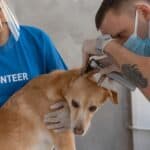
Today we are talking about one of the most common skin diseases in dogs. A danger which, if not dealt with in time, can have very serious, even lethal consequences. Well, how to recognize scabies ?
Scabies and dogs, what you need to know
This disease is caused by the infection of microscopic spider mites . Once hidden in the dog’s skin, they produce a painful inflammation resulting from intense biting.
Even if it all begins with an infection that is localized only in certain parts of the body, its spread is very rapid. The female of these parasites lays 20 to 40 eggs in less than 5 days. Two weeks later, the new mites are ready to breed .
In addition, there are various types of mites and therefore there are different types of scabies. Among these, there are two that most affect adult dogs . Let’s talk about scabies and sarcoptic than demodectic .
Recognizing scabies in time means avoiding a lot of problems for your dog. We will show you which symptoms need to be identified in order to stop the infection caused by these small but deadly mites.
How to tell if your dog has scabies
The mites, thanks to their microscopic size, manage to go unnoticed. So: how to tell if your dog has scabies? Simply by looking at some typical symptoms that reveal the presence of these parasites . Even if you cannot spot them with the naked eye, observe any suspicious behavior of your dog, and be careful if:
- He scratches himself in various parts of his body persistently . The itching caused by parasites is in fact very intense.
- Wounds appear on the skin . Prolonged scratching can lead the animal to cause obvious skin lesions.
- Red spots appear . They are typical of dermodectic scabies.
- Try to scratch against the walls and floor to relieve the itching of the mite bites.
- There are areas of hairless skin .
These 5 points are enough to trigger the alarm. You will have to take the dog to the vet immediately, in order to start treatment as soon as possible. In cases of this type, promptness and speed of response play a fundamental role.
Act now to avoid complications
It is essential to know how to recognize the first symptoms of scabies to avoid worse problems. You need to stop the infection before it spreads all over the body and leads to the proliferation of bacteria and fungi.
If the state of the disease is very advanced, there are three other very evident symptoms that we can easily recognize:
- Smell of rotten.
- Dry, crusted and thick skin.
- Considerable weight loss.
Also consider that, due to the intensity of the itch, the dog can lose his appetite and stop drinking . He will only think about scratching himself, putting his life in serious danger.
How is scabies in dogs treated?
With respect to the type of infection and its degree of progress, the veterinarian will indicate the treatment to be followed . In general, injectable drugs are used together with products for external use. For example shampoos , powders or lotions.
Obviously, the dog must also be given analgesics and anti-inflammatories . The aim is to stop any infections caused by bacteria and fungi in open wounds.
We remind you that treatment should never be stopped without the supervision of the veterinarian . The great danger represented by these mites is that they have the ability to regenerate after days.
How to prevent scabies
The best way to avoid this dangerous disease is, as always, to prevent it . How? If you want to prevent your dog from suffering from scabies, follow these other 5 tips:
- Administer pesticides and vaccines under the veterinarian’s instructions.
- Ensure the animal a balanced and quality diet.
- Take care of its cleanliness by wetting it and combing it regularly.
- Keep the living space clean and ventilated.
- Avoid contact with animals affected by scabies.
A strong, healthy and well-fed animal will never fall victim to these dangerous mites . So take good care of your four-legged friend, carefully observe his behavior and, if in doubt, do not hesitate to contact your veterinarian.






